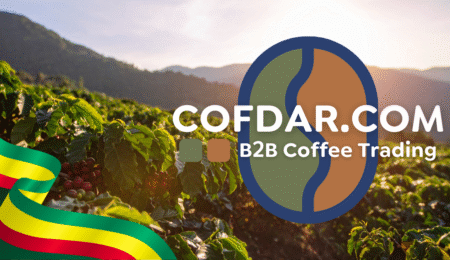The global coffee market has witnessed significant fluctuations in recent months due to supply surpluses, weather volatility, logistical challenges, and shifting trade dynamics. The June 2025 Coffee Market Report issued by the International Coffee Organization (ICO) provides in-depth insights into production, pricing, exports, and market volatility, serving as a valuable resource for producers, exporters, traders, and digital B2B platforms such as Cofdar.
This article delivers a comprehensive summary and strategic analysis of the report’s key findings and presents opportunities for businesses operating in the global coffee supply chain.
1. ICO Composite Price Index Drops Below 300 Cents
One of the report’s headline findings is the drop of the ICO Composite Indicator Price (I-CIP) to 295.06 US cents/lb, marking an 11.8% decline from May 2025. This is the first time since December 2024 that the price index has fallen below 300 cents.
Key factors behind the drop include:
- Global oversupply, especially from Vietnam and Ethiopia.
- Short-term recovery in certified stocks.
- Mixed weather reports from Brazil, the world’s largest coffee producer.
Despite the monthly drop, the I-CIP remains 30.1% higher year-over-year than June 2024, reflecting general upward momentum throughout the last 12 months.
2. Prices Across Coffee Groups Decline
All coffee types reported price drops in June 2025:
| Coffee Group | Price (US cents/lb) | Monthly Change |
|---|---|---|
| Colombian Milds | 360.08 | -9.0% |
| Other Milds | 363.16 | -8.7% |
| Brazilian Naturals | 338.53 | -10.9% |
| Robustas | 196.21 | -17.5% |
Notably, Robusta prices fell below 200 cents/lb for the first time since January 2024, signaling intense downward pressure in that segment.
3. Global Green Coffee Exports: Mixed Trends
In May 2025, total global green coffee exports reached 11.2 million bags, a 3.5% increase from May 2024. Robusta led the growth:
- Vietnam: +87.3% (2.36 million bags)
- Indonesia: +381.6%
- Uganda: +45.9%
Meanwhile, Colombian Milds recorded their first decline after 19 months of growth:
- Colombia’s exports fell by 3.6% YoY.
- Brazilian Naturals dropped by 11.2%, largely due to a cyclical correction.
In contrast, Ethiopia’s exports surged by 40.9%, driven by strong harvests and favorable pricing.
4. Regional Coffee Exports: Sharp Divergences
Exports by region in May 2025 illustrate a deepening gap in supply performance:
| Region | Export Volume (Million Bags) | YoY Change |
|---|---|---|
| Asia & Oceania | 4.11 | +48.9% |
| Africa | 2.33 | +33.3% |
| South America | 4.08 | -25.7% |
| Mexico & Central Am. | 2.13 | +3.8% |
South America, especially Brazil, saw a steep drop due to a base effect after record exports in 2024. Meanwhile, Vietnam and Ethiopia significantly boosted volumes, balancing the global supply.
5. Global Surplus Pressures
According to a semi-annual USDA report:
- The global coffee market is forecasted to face a 9.32 million bag surplus in 2025/26.
- This follows a 7.88 million bag surplus in 2024/25.
These surpluses are putting strong downward pressure on prices and signal longer-term affordability, especially for bulk B2B buyers. It presents a strategic buying window.
6. Weather Reports and Volatility
On June 23, 2025, coffee prices spiked by 3.6% following early reports of frost in Brazil’s key coffee regions (São Paulo and Minas Gerais). However, subsequent forecasts ruled out severe damage, and the rally reversed quickly.
This event reflects the sensitivity of global pricing to weather volatility, especially in Brazil.
Additionally:
- Volatility fell to 10.2%, down from 11.1% in May.
- The New York and London futures markets also saw reduced volatility.
7. Inventory and Market Differentials
- Certified stocks in London and New York dropped slightly in June, indicating depleting reserves despite the surplus outlook.
- The price differential between Colombian Milds and Robustas grew to +163.86 US cents/lb, highlighting a widening quality gap.
- Arbitrage between London and New York widened by 1.9%, signaling increased inter-market opportunity.
8. What Does This Mean for Cofdar Users?
For users of Cofdar, a global B2B coffee trading platform, these market conditions offer a range of strategic benefits:
- Access new supply sources in Africa and Southeast Asia at lower prices.
- Negotiate better terms before the market recovers in Q4 2025.
- Reduce risk with verified suppliers and quality certifications.
9. Strategic Recommendations for B2B Buyers
- Secure long-term contracts now while prices are favorable.
- Diversify sources beyond South America to include Vietnam, Ethiopia, Uganda.
- Use Cofdar to track trends, access certified suppliers, and streamline procurement.
- Consider green coffee auctions and stockpiling ahead of Q4 and potential climate-driven volatility.
The ICO June 2025 report paints a complex picture: a bearish short-term trend driven by oversupply, but tempered by volatile weather and regional imbalances.





Leave a Reply